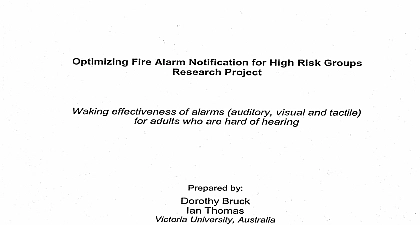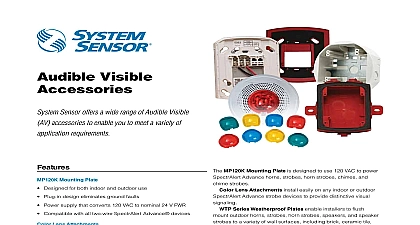System Sensor AV Alarm Effectiveness for Alcohol Impaired

File Preview
Click below to download for free
Click below to download for free
File Data
| Name | system-sensor-av-alarm-effectiveness-for-alcohol-impaired-1328054967.pdf |
|---|---|
| Type | |
| Size | 1.14 MB |
| Downloads |
Text Preview
Fire Alarm Notification for High Risk Groups Project effectiveness alarms auditory visual and tactile the alcohol impaired by Bruck Thomas Ball University Australia THE PROTECTION FOUNDATION r FIRE PROTECTION FOUNDATION BATTERYMARCH PARK MASSACHUSETTS u S A 02169 Foundatlon NFPA org www nfpa org Foundation The Fire Protection Research Foundation 2007 April of 2006 the Foundation was awarded a Fire Prevention and Grant by the US Fire Administration to study the effectiveness alarms for emergency notification of high risk groups The study was to optimize the performance requirements for alarm and systems to meet the needs of these groups Elements of study included a risk assessment to estimate the potential impact lives saved of changes in notification effectiveness of smoke for these groups quantifying the human behavior aspects of problem developing benchmark performance criteria for alarm signaling systems reviewing current and emerging technologies address the performance criteria and assessing the information in the above tasks to develop recommendations on technology for each target group and the overall impact the general population This report is one in a series of four that on the on the results of the study Research Foundation expresses gratitude to the report authors Bruck Ian Thomas and Michelle Ball of Victoria University the Project Technical Panelists listed on the following page to the United States Fire Administration the project sponsor content opinions and conclusions contained in this report are those of the authors Fire Alarm Notification for High Risk Groups Project Panel Coniglio Illinois Department on Aging DiGiovanni Clark County NV Fire Department Elvove General Services Administration Fahy NFPA Fraser SimplexGrinnell Gifford Invensys Controls Firex Laroche University of Ottawa Lee U S Consumer Product Safety Commission Mulvany Proulx National Research Council of Canada Reiswig SimplexGrinnell Richardson NFPA Schifiliti RP Schifiliti Associates Inc Woycheese Worcester Polytechnic Institute Sponsor States Fire Administration No EMW 2005 FP O1258 effectiveness of alarms auditory visual and tactile the alcohol impaired Bruck1 I Thomas2 and M Ball2 of Psychology for Environmental Safety and Risk Engineering CESARE University Australia for the Fire Protection Research Foundation a 2006 2007 US Fire Administration Grant 2007 and alcohol impairment of Contents of Tables 3 of Figures 4 5 Executive summary 6 Review of the Literature 9 Alcohol and fire fatality 9 Alcohol auditory alarms and sleep 12 Non auditory emergency signals and sleep 16 Aims Research Questions and Design Issues 20 Method 23 Participants 23 Apparatus 24 Procedure 27 Data analysis 31 Results 35 Waking Scores 35 Signal Onset and Offset 38 Sex differences 39 Behavioural Response Time 39 Blood Alcohol Content 41 Order of signal presentation effects 42 Discussion 43 Waking effectiveness of different signals 43 Signal onset versus signal onset 47 Sex differences 48 Behavioural Response Time 48 Comparisons to field settings 49 Conclusions and Recommendations 50 References 53 and alcohol impairment A Spectral analyses of auditory signals used 58 B Information about the research project 60 C Sound measurement calibration and signal delivery aspects 62 D Screening questionnaire re sleep deprivation and alcohol 64 E Photos of the strobe lights bed shaker and pillow shaker 65 F Data record sheet for pillow bed shaker pillow mattress type 66 G Strobe alignment and measurements only required when strobe light is to be presented 68 H Details of the blood alcohol testing equipment and procedure 69 of Tables 4.1 Temporal specifications of signal delivery 30 4.2 Temporal and intensity details of auditory and tactile signal presentations and Waking Score 33 5.1 Number and percentage of participants in terms of their waking behaviour to signals with 05 BAC 35 5.2 Descriptive statistics for the Waking Scores for all signals 36 5.3 The means standard deviation and statistical results for the Waking Scores all signals as a function of sex 39 5.4 Descriptive statistics for behavioural response time in seconds across the signals 40 5.5 Mean differences between behavioural response and EEG awake times 40 5.6 Percentages of participants at different blood alcohol content BAC levels at time points 41 C 1 Sound meter settings for creating the different sound files 62 and alcohol impairment of Figures 2.1 Comparison of the mean dBA levels of different alarms required to awaken adults under different blood alcohol content conditions n 12 14 4.1 Flash pattern of the strobe lights as a function of time in seconds 26 5.1 Cumulative frequency graphs for Waking Scores for the four auditory


